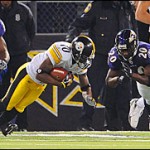The biggest and most controversial play (see video) in the NFL last week decided the Pittsburgh Steelers’ victory over Baltimore. Steelers Beat Ravens; Titans Await [Pittsburgh Tribune].
Flushed out of the pocket on third down, Roethlisberger kept the play alive long enough to fire a bullet to Holmes in a shallow part of the end zone. Ed Reed quickly shoved Holmes back across the goal line and officials initially ruled Holmes down at the 1-yard line. They changed the call to a touchdown after an official review. Afterward, referee Walt Coleman said that Holmes established both feet in the end zone [with possession of the ball] before Reed pushed him out.

Debate raged all week throughout the blogospghere, newspaper message boards, fan sites and on TV talk shows (like Inside the NFL) over whether the replay officials got it wrong. The conventional theory is that Holmes should not have been credited with a TD because the football did not cross into the end zone, that replay should not have reversed the on-field call because there wasn’t “indisputable” evidence on the replay video and that the referee’s explanation was botched.
My belief is that all of this controversy misses the point. Even the NFL’s unofficial rules digest defines a touchdown with reference to breaking the plane. “Touchdown: When any part of the ball, legally in possession of a player inbounds, breaks the plane of the opponent’s goal line, provided it is not a touchback.” But it also defines the field in terms which make clear that breaking the plane is not the sin qua non of a TD. “Sidelines and end lines are out of bounds. The goal line is actually in the end zone. A player with the ball in his possession scores a touchdown when the ball is on, above, or over the goal line.”
Take these two hypotheticals.
1. The QB rolls out wide and passes the football toward the end zone pylon but it crosses the goal line outside of the field of play. With the ball still in the air and both feet planted in the end zone, the receiver catches the ball, maintains possession and falls to the ground out of bounds. The football has never broken the plane of the end zone but the receiver had legal possession while in the end zone. Result? TD. No one could argue otherwise, else many “fade” routes would not be scores.
2. A runner comes down the field, ahead of the defense, holding the ball. Nearing the end zone, in celebration, the runner holds the ball out to his side, outside the pylon, as he runs into the end zone. So the player has possession of the ball in the end zone but the ball never broke the plane. Result? TD. Whether or not the ball crossed the plane, the player has possession of the ball with two feet in the end zone.
So what does the official NFL rule book say? Well, crap, it’s not online. I did find a copy of the 2006 rule book available, which provides in Rule 3, Section 2, Article 7:
To gain possession of a loose ball (3-2-3) that has been caught, intercepted, or recovered, a player must have complete control of the ball and have both feet completely on the ground inbounds or any other part of his body, other than his hands, on the ground inbounds…. This rule applies in the field of play and in the end zone. The terms catch, intercept, recover, advance, and fumble denote player possession (as distinguished from touching or muffing). A catch is made when a player inbounds secures possession of a pass, kick, or fumble in flight (See 3-20; 8-1-7-S.N. 5).
Yet the official definition of a touchdown also seems to require the ball to break the plane. Rule 3, Section 38 says “A Touchdown is the situation in which any part of the ball, legally in possession of a player inbounds, is on, above, or behind the opponent’s goal line (plane), provided it is not a touchback (11-2).”
Mystery solved. But the NFL surely needs to publicize its 2008 rule book and clarify whether it is both possession “and” location of the ball that are required for a TD if the player is in the end zone.
Let the debate continue!

